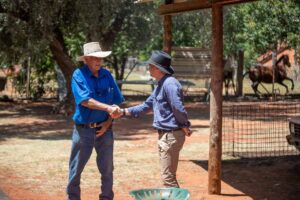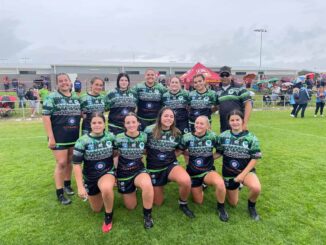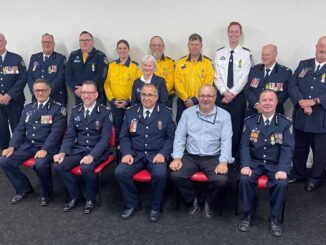
The Billagoe (Mount Drysdale) Cultural Landscape has been listed on the NSW State Heritage Register, recognising its long and diverse history.
The listing recognises Billagoe (Mount Drys-dale) as an important multi-layered cultural landscape illustrating the shared history of NSW and protects it for generations to come.
Mount Drysdale’s owners, Shirley and Mi-chael Mitchell, have been working with local indigenous people for more than 30 years to preserve the heritage of the area.
“Shirley’s people have been on the place for over 100 years,” Michael told The Cobar Weekly.
“The listing is a real good thing, it protects everything—all the buildings, the old cottage and the Aboriginal areas,” he said.
Heritage Minister James Griffin made the listing announcement last Thursday on a visit to Mount Drysdale and said he was proud the Billagoe Cultural Landscape, which is an out-standing example of a spiritual and cultural landscape, was being listed.
“Billagoe (Mount Drysdale) has rich cultural significance to the Indigenous people of the Ngemba-Ngiyampaa-Wangaaybuwan-Wayilwan and Baiame, the ancestral creator of landscapes and resources,” Mr Griffin said.
“It’s important that we recognise and pre-serve the deep history of this site and I am pleased that my first listing as Heritage Minis-ter is one that celebrates NSW’s rich Aborigi-nal heritage.
“The site forms part of the Baiame cycle of creation stories and is linked to other signifi-cant places such as Cobar, Gundabooka Na-tional Park, Byrock Rockholes Aboriginal Place and the nationally and state listed Ngunnhu (Brewarrina Fishtraps).”
The Billagoe (Mount Drysdale) Cultural Landscape is of state significance for its rare Aboriginal archaeology linked to ceremony, axe manufacturing, trade and social sites.
Located 34km north of Cobar on the Kidman Way, Mount Drysdale in 1893 was a bustling town with a population of approximately 5,000 and the site of a prosperous mine.
Preserved by the Mitchell family, the site today still has examples of 19th/early 20th century gold mining infrastructure and Chinese market gardens, and a rare surviving example of a government caretaker’s cottage, built in circa 1895.
As a multi-layered cultural landscape with shared history, it also has the ability to demon-strate the technology of water storage in an arid landscape, a theme that links the Indige-nous, pastoral, mining and Chinese history.
“The listing of Billagoe (Mount Drysdale) Cultural Landscape celebrates and helps to protect unique and culturally important aspects of the Aboriginal and non-Aboriginal history of NSW,” Mr Griffin said.
State Member for Barwon, Roy Butler, joined the Minister on his western area tour last week and welcomed the heritage listing.
Mr Butler said he was pleased the Minister was able to also speak with a number of locals and hear first hand their stories and concerns.
“Hopefully this locally gained knowledge will translate to more good outcomes for re-gional NSW,” Mr Butler said.


